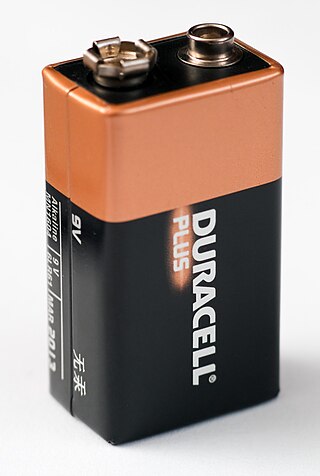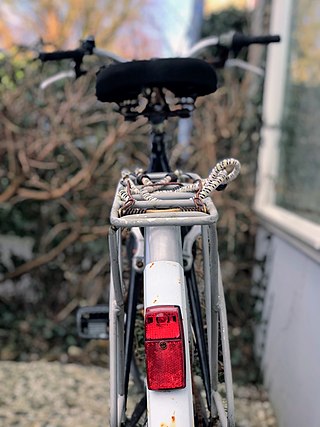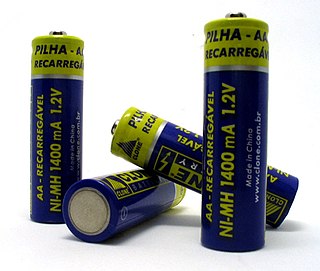
The nickel–cadmium battery is a type of rechargeable battery using nickel oxide hydroxide and metallic cadmium as electrodes. The abbreviation Ni–Cd is derived from the chemical symbols of nickel (Ni) and cadmium (Cd): the abbreviation NiCad is a registered trademark of SAFT Corporation, although this brand name is commonly used to describe all Ni–Cd batteries.

A rechargeable battery, storage battery, or secondary cell, is a type of electrical battery which can be charged, discharged into a load, and recharged many times, as opposed to a disposable or primary battery, which is supplied fully charged and discarded after use. It is composed of one or more electrochemical cells. The term "accumulator" is used as it accumulates and stores energy through a reversible electrochemical reaction. Rechargeable batteries are produced in many different shapes and sizes, ranging from button cells to megawatt systems connected to stabilize an electrical distribution network. Several different combinations of electrode materials and electrolytes are used, including lead–acid, zinc–air, nickel–cadmium (NiCd), nickel–metal hydride (NiMH), lithium-ion (Li-ion), lithium iron phosphate (LiFePO4), and lithium-ion polymer.

A flashlight or electric torch, usually shortened to torch, is a portable hand-held electric lamp. Formerly, the light source typically was a miniature incandescent light bulb, but these have been displaced by light-emitting diodes (LEDs) since the early 2000s. A typical flashlight consists of the light source mounted in a reflector, a transparent cover to protect the light source and reflector, a battery, and a switch, all enclosed in a case.

A transistor radio is a small portable radio receiver that uses transistor-based circuitry. Previous portable radios used vacuum tubes, which were bulky, fragile, had a limited lifetime, consumed excessive power and required large heavy batteries. Following the invention of the transistor in 1947—which revolutionized the field of consumer electronics by introducing small but powerful, convenient hand-held devices—the Regency TR-1 was released in 1954 becoming the first commercial transistor radio. The mass-market success of the smaller and cheaper Sony TR-63, released in 1957, led to the transistor radio becoming the most popular electronic communication device of the 1960s and 1970s. Transistor radios are still commonly used as car radios. Billions of transistor radios are estimated to have been sold worldwide between the 1950s and 2012.

Duracell Inc. is an American manufacturer of alkaline batteries, specialty cells, and rechargeables; it is a wholly owned subsidiary of Berkshire Hathaway since 2016. The company has its origins in the 1920s, through the work of Samuel Ruben and Philip Mallory, and the formation of the P. R. Mallory Company.
Eveready Battery Company, Inc. is an American manufacturer of electric battery brands Eveready and Energizer, owned by Energizer Holdings. Its headquarters are located in St. Louis, Missouri.

Energizer Holdings, Inc. is an American manufacturer and one of the world's largest manufacturers of batteries, headquartered in Clayton, Missouri. It produces batteries under the Energizer, Ray-O-Vac, Varta, and Eveready brand names and formerly owned several personal care businesses until it separated that side of the business into a new company called Edgewell Personal Care in 2015.

Bicycle lighting is illumination attached to bicycles whose purpose above all is, along with reflectors, to improve the visibility of the bicycle and its rider to other road users under circumstances of poor ambient illumination. A secondary purpose is to illuminate reflective materials such as cat's eyes and traffic signs. A third purpose may be to illuminate the roadway so that the rider can see the way ahead. Serving the latter purposes require much more luminous flux and thus more power.
A primary battery or primary cell is a battery that is designed to be used once and discarded, and it is not rechargeable unlike a secondary cell. In general, the electrochemical reaction occurring in the cell is not reversible, rendering the cell unrechargeable. As a primary cell is used, chemical reactions in the battery use up the chemicals that generate the power; when they are gone, the battery stops producing electricity. In contrast, in a secondary cell, the reaction can be reversed by running a current into the cell with a battery charger to recharge it, regenerating the chemical reactants. Primary cells are made in a range of standard sizes to power small household appliances such as flashlights and portable radios.

A mechanically powered flashlight is a flashlight that is powered by electricity generated by the muscle power of the user, so it does not need replacement of batteries, or recharging from an electrical source. There are several types which use different operating mechanisms. They use different motions to generate the required power; such as squeezing a handle, winding a crank, or shaking the flashlight itself. These flashlights can also be distinguished by the technique used to store the energy: a spring, a flywheel, a battery or a capacitor.

VARTA is a German company manufacturing batteries for global automotive, industrial, and consumer markets.

Eveready Industries India Ltd. (EIIL) is an Indian company that manufactures and markets batteries and lighting products. The Eveready brand has been present in India since 1905. It also manufactures photogravure plates, castings, carbon electrodes and related products.

The Directive 2006/66/EC of the European Parliament and of the Council of 6 September 2006 on batteries and accumulators and waste batteries and accumulators and repealing Directive 91/157/EEC, commonly known as the Battery Directive, regulates the manufacture and disposal of batteries in the European Union with the aim of "improving the environmental performance of batteries and accumulators".

The lithium iron phosphate battery or LFP battery is a type of lithium-ion battery using lithium iron phosphate as the cathode material, and a graphitic carbon electrode with a metallic backing as the anode. Because of their low cost, high safety, low toxicity, long cycle life and other factors, LFP batteries are finding a number of roles in vehicle use, utility-scale stationary applications, and backup power. LFP batteries are cobalt-free. As of September 2022, LFP type battery market share for EVs reached 31%, and of that, 68% were from EV makers Tesla and BYD alone. Chinese manufacturers currently hold a near monopoly of LFP battery type production. With patents having started to expire in 2022 and the increased demand for cheaper EV batteries, LFP type production is expected to rise further and surpass lithium nickel manganese cobalt oxides (NMC) type batteries in 2028.
Midland Radio Corporation, also known as Midland Radio, or just Midland, is a manufacturing company, headquartered in Kansas City, Missouri, US. Midland Radio develops radio communications products.

Freeplay Energy Ltd, , is a manufacturer and distributor of portable electrical or electronic products such as radios and lights, generally powered by hand cranked generators that charge rechargeable batteries. The company is based in London, UK. The company focuses on creating and developing the international market for self-sufficient energy products, and states that such a focus will help promote education and access to important information throughout the developing world. The company has expanded its market to include outdoor leisure and emergency preparedness markets, seeing the clear demand for self-powered products in such off-grid environments.
Spectrum Brands Holdings, Inc. is an American diversified company headquartered in Middleton, Wisconsin. It was established in 2005 as the successor to Rayovac Corporation.
Pelican Products is an American multinational company that designs and manufactures portable lighting systems, temperature controlled packaging and protective cases. Their products are used in many industries including military, law enforcement, fire safety, and consumer entertainment. The company's flagship product, Pelican cases, are molded plastic cases that seal with an airtight and watertight gasket. Pelican is based in Torrance, California. In Europe the products are branded Peli.

An electric battery is a source of electric power consisting of one or more electrochemical cells with external connections for powering electrical devices. When a battery is supplying power, its positive terminal is the cathode and its negative terminal is the anode. The terminal marked negative is the source of electrons. When a battery is connected to an external electric load, those negatively charged electrons flow through the circuit and reach to the positive terminal, thus cause a redox reaction by attracting positively charged ions, cations. Thus converts high-energy reactants to lower-energy products, and the free-energy difference is delivered to the external circuit as electrical energy. Historically the term "battery" specifically referred to a device composed of multiple cells; however, the usage has evolved to include devices composed of a single cell.

Solar powered flashlights or solar powered torches are flashlights powered by solar energy stored in rechargeable batteries. Most of these flashlights use light-emitting diodes lamps since they have lower energy consumption compared to incandescent light bulbs.















